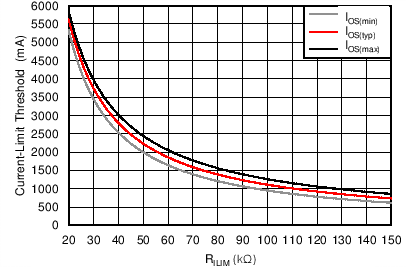SLVSC97B March 2014 – September 2020 TPS2556-Q1 , TPS2557-Q1
PRODUCTION DATA
- 1 Features
- 2 Application
- 3 Description
- 4 Revision History
- 5 Device Comparison Table
- 6 Terminal Configuration and Functions
- 7 Specifications
- 8 Detailed Description
- 9 Applications and Implementation
- 10Power Supply Recommendations
- 11Layout
- 12Device and Documentation Support
- 13Mechanical, Packaging, and Orderable Information
Package Options
Mechanical Data (Package|Pins)
- DRB|8
Thermal pad, mechanical data (Package|Pins)
- DRB|8
Orderable Information
9.2.2.2 Programming the Current-Limit Threshold
The overcurrent threshold is user-programmable via an external resistor. The TPS2556-Q1 and TPS2557-Q1 devices use an internal regulation loop to provide a regulated voltage on the ILIM terminal. The current-limit threshold is proportional to the current sourced out of ILIM. The recommended 1% resistor range for RILIM is 20 kΩ ≤ R(ILIM) ≤ 187 kΩ to ensure stability of the internal regulation loop. Many applications require that the minimum current limit be above a certain current level or that the maximum current limit be below a certain current level, so it is important to consider the tolerance of the overcurrent threshold when selecting a value for RILIM. The following equations approximate the resulting overcurrent threshold for a given value of external resistor RILIM. Consult the Electrical Characteristics table for specific current-limit settings. The traces routing the RILIM resistor to the TPS2556-Q1 and TPS2557-Q1 devices should be as short as possible to reduce parasitic effects on the current-limit accuracy.

 Figure 9-2 Current-Limit Threshold versus R(ILIM)
Figure 9-2 Current-Limit Threshold versus R(ILIM)